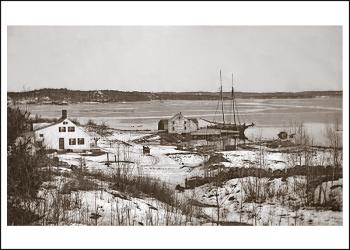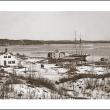Photo launches search into history of McCarty Cove, Part I
Every spring for many years I have come to my family’s place on Westport Island in midcoast Maine and carefully taken from the old horsehair plaster wall a fragile framed photo that beckons me into the past. Most recently I saw something mysterious in that picture that I hadn’t noticed before. I needed magnification to see it. What I saw got my imagination racing.
One is easily drawn into this sweeping black-and-white photograph of the same place in winter probably taken in the late 1800s when it was a ship’s chandlery. Many current residents of the island have also taken in this iconic scene, as the same photo graces the cover of a history of Westport published in 1993 and still available at the town offices.
Looking toward the Sheepscot River from a short hill, the photographer captures a quintessential coastal Maine home and schooner landing. A horse-drawn sleigh carves through light snow cover past a tidy white saltbox house with dark shutters and a good view of the river and the working waterfront below. There’s the chandlery, hard by a huge wooden pier with a two-masted schooner nestled alongside.
The ship’s mastheads puncture the overcast sky. Her main boom holds gobs of furled heavy canvas and is so long that if it got loose in a stiff northeast breeze it might swing across the pier and smack the side of the chandlery. The slightest breeze lightly ripples the chilly river. The scene draws a wistful sigh, as I wonder about this place and the people who lived in that long-ago-burned house just up the rise, people who worked that schooner and stored their sails and perhaps sold goods in the very place that shelters me now 100 or more years later.
Who is that guy looking into the schooner?
Before placing the dusty black frame back on the wall, I get out my smart phone and snap a new photo of the old photo. Later, I stroll through the scene again, using my fingers like tweezers on the phone’s screen to enlarge the image. Tiny in the distance and the dimness of the old photo there’s another schooner lying at anchor further upriver toward Wiscasset. I have noticed that ship in the picture before with the naked eye but it’s even more intriguing to see it enlarged with the aid of technology and a flick of my fingers.
I keep scanning. Then I see something else that I’d never seen in all these years. It’s a lone human figure. The sight of him hits me like a virtual boom across the head. His back is to me. My fingers twitch trying to make the image larger. He’s standing, bulky and bundled up, on the edge of the pier looking into the schooner’s helm.
Today all the structures in the photo are gone except for the chandlery and the granite pilings that supported the huge pier. The pier itself has long since rotted away and the pretty little white house on the hill burned in the early 1900s, not long before my grandparents, Alvin F. Sortwell Jr. (of the Wiscasset Sortwells) and wife, Elise, bought the property and turned the old chandlery into a summer place. The family that had lived and worked on this waterfront operation bounded by a cove on one side and the Sheepscot on the other faded into history along with the age of sail itself.
The search begins
Questions hover like mist. Just who was it in the photo, standing on the pier that day? Was he the captain? Where had the schooner been? What was its next destination? How about that other schooner in the distance? This is the story of what I found as I searched for the ships and captains of McCarty Cove, Westport Island.
As I imagine is the case all up and down the Maine coast, family graveyards and fading headstones are often the starting place for learning about the early seafarers who settled nearby. So it was for me with the McCarty’s. As a child I trudged with my mother in search of the McCarty graveyard, through the thick woods several hundred yards inland and upland of where that little white farmhouse had stood. It was always a great, if creepy, relief to find the little three-row plot, framed by a corroding wrought-iron fence. All the granite-inscribed birth and death dates were sobering, especially since I knew they were people who had walked and worked the land I stood on and water I swam (at least on really hot days in August).
The inscription that fascinated me the most was “lost at sea.” And that phrase attached to more than one memorial headstone in the McCarty graveyard. Lost at sea. How did it happen? Was it that guy on the dock by the schooner in the photo? His uncle or cousin? What could I learn about these seamen that sailed far and wide, casting off from that pier in the photo?
You never know what you might find till you start digging. There were hundreds or perhaps thousand of ships and captains hailing from mid-coast Maine, dozens and dozens from Westport Island alone.
A treasure chest for anyone looking for the stories of Maine ships and captains is the archives of the Maine Maritime Museum in Bath, where I found plenty of information on little index cards, each one revealing another piece of the puzzle of the rich seafaring history of the McCarty’s of Westport Island. They were an enterprising 19th century Maine family who like many others built their lives around the sea and what it offered.
More on the McCarty’s later, but the most fascinating find at the Bath MMM was a McCarty family connection to a notorious case of murder on the high seas.
There is no mention in any records I’ve seen of any Westport McCarty him- or herself having killed or been killed by anyone at sea or on land, though the family certainly lost its share of McCarty captains to the sea over the 100 years for which their maritime exploits are documented. Rather it was the scene of the crime, the ship itself, that connected directly to another Maine captain with Westport connections, Thomas McLaughlin. He married a McCarty girl.
Look for the second installment, including more on the shipboard murder case, at a later date.
Harry Castleman can be contacted at hcharryc@aol.com
Special thanks to Maine Maritime Museum Senior Curator Nathan Lipfert and the staff of the museum library.
Event Date
Address
United States




































